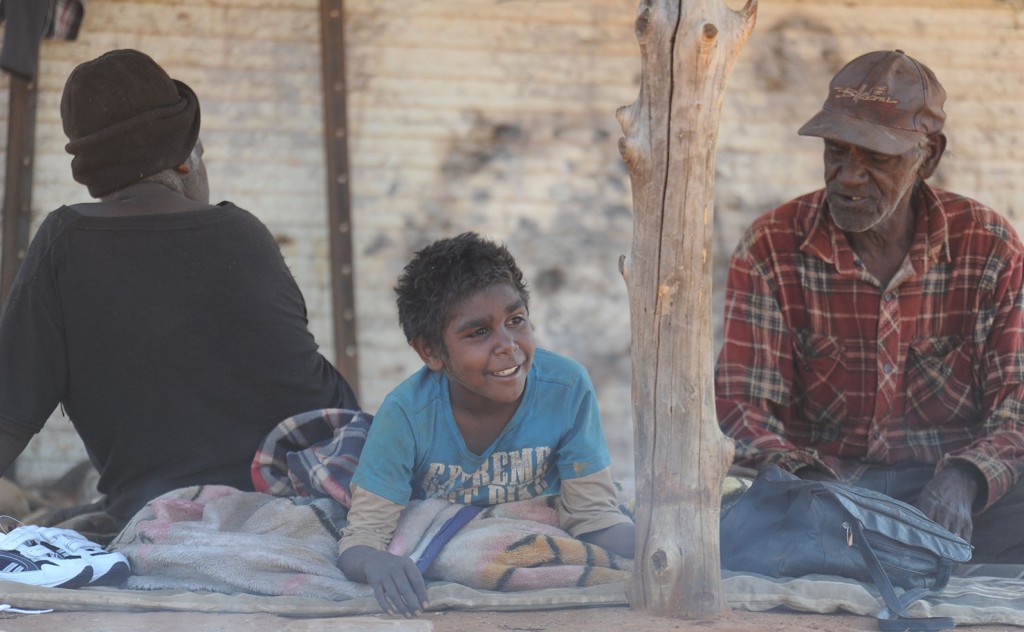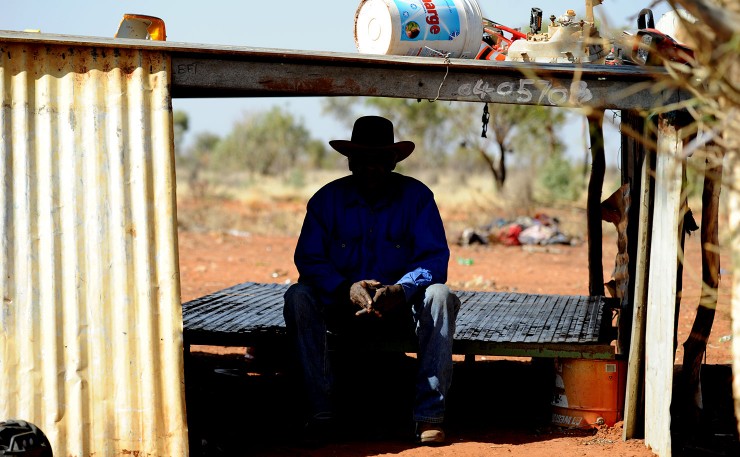In the recently released White Paper on Developing Northern Australia, it is noted that many Indigenous Australians say that native title rights do not provide a basis for active participation in the economy.
Indigenous Australians sometimes talk about being ‘land rich, dirt poor’. In many cases, the White Paper suggests, native title does not currently provide a secure asset that promotes investment, unlike other Australians who can borrow against freehold title in their own home or business.
The issue of ‘land rich, dirt poor’ has bedevilled both land rights and native title in remote Australia for well over 40 years.
The term was first deployed in Australia, from my recollection, in a National Press Club speech by Amanda Vanstone in February 2005 when she was Minister for Indigenous Affairs; she, or her speech writer, appear to have borrowed the term from Cherokee Indigenous rights advocate and businesswoman Rebecca Adamson who asked in 2003 why is it that native Americans are ‘land rich and dirt poor’, why can’t they turn their considerable land assets into more conventional forms of economic wealth and wellbeing?
A decade earlier I was present in the Mural Hall in Parliament House when the then Prime Minister Paul Keating gave one his memorable speeches that is rarely recalled today. The occasion was the acceptance of the report Going Forward: Social Justice for the First Australians delivered by the Council for Aboriginal Reconciliation headed by Patrick Dodson.
It was a giddily progressive time as the speech was given just a day after the High Court had rejected a constitutional challenge to the Native Title Act by Western Australia.
But the phrase that still rings in my mind today, perhaps because of the way Keating almost spat it out with the invective that was an endearing feature of his statesmanship was: ‘Beware the whispered word, workable’.
Keating was warning those assembled that ‘workable’ was the password of the diehards opposed to native title and he was referring to the then Opposition Leader John Howard and then WA Premier Richard Court.
Keating was well aware of the shortcomings of native title, particularly for those whose rights had been extinguished. Hence he established the compensatory Aboriginal and Torres Strait Islander Land Fund; and committed to a social justice package that has never been delivered. He was deeply concerned that the possibilities for economic and social progress embedded in native title law would be reduced or eliminated.
In the last two years, since the election of the Abbott government, we have seen escalating concerns about the ‘workability’ of land rights and native title laws in remote Australia, not all expressed, I should make clear, by what Keating would have referred to as the ‘diehards’.
Some now expressing concern on the absence of economic development from native title quoted by the White Paper include champions of land rights and native title like Patrick Dodson and Mick Gooda and the Kimberley Land Council and the Wimun Ngari Aboriginal Corporation.
Besides the White Paper and its commentary on the links between land rights and native title reform and the economic development of the north, we have seen escalating proposals for policy reform on this issue.

There have been the continuing attempts by the Abbott government to facilitate ‘voluntary’ section 99-year leasing of Aboriginal townships in the Northern Territory (with no success two years on) in the name of home ownership and business development.
And in November 2014 the Council of Australian Governments announced that it would undertake an urgent investigation into Indigenous land administration and use, to be undertaken by a Senior Officers Working Group working with an Expert Indigenous Working Group.
In April this year, the Australian Law Reform Commission released its comprehensive report Connection to Country: Review of the Native Title Act 1993 commissioned in the last days of the Gillard government.
And most recently in May we have seen the intervention of the Australian Human Rights Commission into this policy space with the convening of the Broome Roundtable on economic development and property rights implying that a link between land, development and property rights is a human right. Indeed, in 1986 the United Nations General Assembly adopted a Declaration on the Right to Development as a group right of peoples.
Noel Pearson has recently picked up this discourse when he wrote after the Broome Roundtable in The Australian ‘We have to advocate for the right to development. This is our true right’. And later ‘A right to development is a freedom. It is the freedom of property. It is the notion of property as a human right’.
At the heart of this resurfaced concern about native title property rights is a policy concern that despite unimagined land holdings in north Australia (nearly half is currently held under some form of Indigenous title), Aboriginal people remain absolutely and relatively impoverished according to standard social indicators.
This makes little sense in a global economy where capitalist logic suggests that land and resource scarcity should place a high market value on such commodities.
And so the emerging policy agenda is to put dynamism into land rights and native title and to re-engineer existing institutions initially designed to protect Indigenous peoples from rampant development for active engagement with market capitalism for Indigenous profit.
Such concerns and attempts are not new, one only needs to look back to 1998 when John Reeves raised similar concerns in his review Building on Land Rights for the Next Generation. This review proved very unpopular, both with Aboriginal people in the Northern Territory and a bipartisan parliamentary committee that reviewed the review and rejected all its recommendations.
At the heart of current concerns are two apparent contradictions.
First, to get back their land, Indigenous claimants need to legally demonstrate continuity of rights and interests under traditional laws acknowledged and traditional customs observed and to demonstrate continuity of connection with lands and waters since colonisation. Similar requirements are stipulated in earlier land rights law to demonstrate primary spiritual responsibility for land and to have a right to forage, to economically use, land claimed.
Such special relationship with land that is usually of low commercial value, in turn requires land owners to live remote from mainstream work opportunities. The maintenance of tradition that is required to claim the land, and hold it, geographically disadvantages land holders in their engagements with 21st century global capitalism. This also raises important questions about what constitutes ‘economic development’ from the perspective of Indigenous land owners.
Second, in accord with tradition land is inalienable. There was no trade in land pre-colonially and so land was passed inter-generationally on the basis of descent. And so there was no market in real estate, no willing sellers and buyers, the key element in market valuation of land. Similarly the High Court in the Ward judgment of 2002 dismissed the notion of native title constituting resource ownership instead viewing it as ‘a bundle of rights’ that exclude valuable sub-surface minerals deemed vested in the crown, or government.
I am not convinced that inalienability is a major hurdle to development. For example the Australian government emphasises that even 99-year leasehold of townships still leaves underlying title vested with traditional owners. And as literally hundreds of future act and Indigenous Land Use Agreements show, land can be leased for monetary returns. Even with mining, the High Court has recently found that native title rights and interests can be suppressed and then, owing to the workings of the non-extinguishment principle, revived.
What is more significant, in my opinion, is the issue of property rights and the legal finding that mineral ownership is vested with the crown alongside state assertion of exclusive rights to own and regulate valuable natural resources like fresh water, fisheries and even carbon for commercial purposes.
This is an issue replete with paradoxes and emerging contradictions. For example, in 1999 the High Court found, in the Yanner judgment that native title law under S211 guaranteed the rights of holders to customary domestic, non-commercial, rights to resources. But these resources can be identical to commercial ones.

Take fresh water as an example: customary entitlement is entirely unrestricted whereas commercial allocation is regulated by government. But the resource is identical and use for customary purposes can impact on use for commercial purposes and vice versa. Indeed, while not yet legally tested, if commercial over-allocation impacts on the customary rights of native title holders (not just potable water but also water dependent species like fish) then compensation for loss of native title rights and interests might be payable.
And in 2013 in the Torres Strait Regional Sea Claim Akiba judgment the High Court found that historically Islanders traded in fish and so their native title rights could be exercised for commercial purposes. Arguably this judgment is at loggerheads with the High Court Ward judgment over a decade earlier.
These are property rights issues with relatively deep history in the Australian policy context.
Up until the 1950s, Aboriginal resource rights were unrecognised but received some protection on crown lands reserved for their use. Then in 1952, in a stunningly progressive move Paul Hasluck came upon the idea of committing all royalties raised on reserves in the Northern Territory (over which as Minister of Territories he had control) for Aboriginal use.
In 1973, the even more progressive Edward Woodward was commissioned by the Whitlam government to provide a means to transfer ownership of unalienated land and sub-surface mineral rights to Aboriginal people in the Northern Territory. He did the former very effectively, but refused to countenance the latter partly bowing to political pressure from the mining industry lobby that this was a step too far. This was a big opportunity missed in terms of Aboriginal resource rights.
Woodward’s recommendations in 1974 were largely incorporated in the Aboriginal Land Rights (Northern Territory) Act 1976 and this has set the high water mark in Aboriginal resource rights, but arguably this has been set too low. Instead of a de jure right in minerals as Whitlam sought, Aboriginal traditional owners were provided with a de facto right in the form of right of consent or right of veto provisions. As Woodward famously said ‘to deny Aborigines the right to prevent mining on their land is to deny the reality of their land rights’.
This right of veto, ‘free prior and informed consent’, provides a form of leverage that Aboriginal traditional owners have been able to utilise in negotiations with resource developers to extract a share of mineral rent in benefit sharing agreements. As well, like Hasluck, Woodward recommended that the Australian government forego its royalty right in favour of Aboriginal interests and so in the Northern Territory the equivalents of royalties are divided between traditional owners of areas affected, their representative organisations, and other Aboriginal people in the Northern Territory via allocations from the Aboriginal Benefit Account.
In my view Woodward was too pragmatic, although if he had recommended full mineral rights for Aborigines this may not have been incorporated in the law passed by the Fraser government.
Unfortunately, the Native Title Act framework provides native title groups a far weaker property right, a mere right to negotiate with a window of opportunity of six months, at best, and a right of consultation, at worst. This has resulted in many benefit sharing agreements, although whether they are equitable remains a contentious point.
And as Indigenous people get back more and more of the continent, political pressure continues to deprive them of ownership of commercially valuable resources: minerals, fisheries and fresh water. And as resource hungry developers look to explore and exploit Indigenous lands, there is a risk that disparities between Indigenous and non-Indigenous Australians might increase rather than decline.
Equally unfortunately, while the dominant approach to Indigenous development focuses on ‘mainstreaming’ the only guarantees that Indigenous people have to resources are outside the market system. So, Indigenous groups may be guaranteed ‘customary’ non-market rights, but not commercial market rights.
The Australian Law Reform Commission has produced the only policy response to grasp this key issue when it recommends that native title rights and interests might be exercised for any purpose, including the commercial alongside hunting, fishing, gathering and trading rights and interests. This is a means to empower Indigenous land owners to have the freedom to make development choice, although such policy reform could exacerbate wealth and wellbeing differentials between those who own land and those who do not.
Others like the White Paper and the Australian Human Rights Commission focus too much on real or imagined over-regulation of Indigenous lands and seek the removal of what Mick Gooda and Tim Wilson refer to as ‘red and green tape that stifles Indigenous development’. This all sounds too much like Keating’s warnings about ‘workability’ and risks change that will be structural and disempowering of the Indigenous disadvantaged in favour of the rich and powerful.
It might be timely for those who champion ‘rights to development’ to advocate for stronger Indigenous property rights either by making them inclusive of commercial rights, at best, or by making them the equivalent of the free prior informed consent rights proposed by Justice Woodward and embedded in land rights law nearly 40 years ago.
Such advocacy might see prospects for Closing the Gap enhanced for those Indigenous people who prioritise development in the mainstream while simultaneously enhancing livelihood prospects from alternate forms of development for those who choose otherwise.
As the Broome Communiqué of May 2015 noted there are tensions between cultural matters, environmental protection and development objectives. Stronger native title property rights are a potentially important means to ameliorate such tensions.
A version of this article was published in Land Rights News Northern Edition August 2015/Edition 3.
Donate To New Matilda
New Matilda is a small, independent media outlet. We survive through reader contributions, and never losing a lawsuit. If you got something from this article, giving something back helps us to continue speaking truth to power. Every little bit counts.





